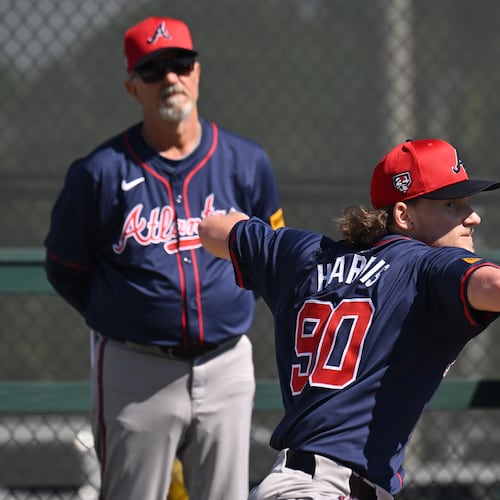Braves starter Mike Soroka is in good spirits a couple of weeks after undergoing surgery on his torn right Achilles tendon.
Soroka tore his Achilles while running to cover first in an Aug. 3 start against the Mets. It ended the young ace’s season. Five days later, he underwent surgery performed by Dr. Robert Anderson in Green Bay, Wisconsin.
“Everything is feeling great,” Soroka said Wednesday, which was his first time speaking with reporters since the injury. “Dr. Anderson did a great job. Best in the business for a reason. Talking to some other people who’ve had it previously, as far as post-surgery goes, I did pretty well. A lot of that is thanks to his great work. Very happy to have that connection in our medical staff. They did an amazing job learning as we go too.”
The injury was a devastating blow for Soroka and the Braves, who were watching their All-Star assert himself as one of the sport’s better pitchers. He started only three games this season, including his first opening-day outing.
When Soroka went down in the third inning, it was fairly clear he sustained an Achilles injury. He knew his season was likely finished.
“As far as pain goes, it was much more of an unsettling feeling than anything else,” he said. “I’d say as soon as I realized that ball didn’t hit me in the back of the ankle, when I went down, I knew what had happened. I’ve pulled enough muscles to know that it wasn’t muscle related. I heard it too.”
The 22-year-old is now in the early stages of a lengthy rehab process. He’ll be in a cast for roughly nine more days before moving into a boot.
Recovery timelines vary with Achilles injuries. He’s talked frequently with Cardinals starter and Georgia native Adam Wainwright, who tore his Achilles in April 2015 but returned five months later as a reliever. He’ll soon speak with Yankees reliever Zach Britton, who ruptured his Achilles in December 2017 and didn’t pitch in the majors until June 2018.
“Adam Wainwright came back and pitched in the playoffs, I think it was five months after surgery, right around there,” Soroka said. “That’s the short end of it. I’ve texted with him quite a bit about what to expect going forward. Again, he did his (landing) leg as well, so that was a little bit different of a challenge than I’ll have. I’d like to be on the short end. I think everybody would. It’s going to be a matter of making sure everything is strong, especially in some of the positions I get into off the mound.
“I’m a little more quad-dominant in my push. My knee falls over my front toes a little bit, creating a bit more range of motion there. It’s something to look at in my mechanics to be honest with you. Something I should’ve fixed a long time ago. Not even about the Achilles but loading my back hip as so many have talked about with pitching mechanics. That might be an opportunity to correct that little flaw and it might help me out.”
If Soroka follows the five-to-six-month road map, he theoretically could be ready early next season. It could also take weeks or months longer, which is why Soroka nor anybody with the team will make a projection at this stage.
The right-hander understands how diligent the process must be, and if that requires longer than the best-case scenario, he isn’t going to cut any corners.
“If it takes longer, we’re going to make sure we do it right,” Soroka said. “The last thing you want is to be dealing with nagging issues in that spot hindering my performance on the mound. At the end of the day, we’d rather take that extra month if we need to to make sure everything is ready to go. That goes for being on the mound and building up innings, too.
"It’s almost going to be more of making sure I’m able to pivot and cover first again as opposed to just throwing on the mound. It’s going to be different that way. I’d love to be on the short end, but if it takes an extra month, I will completely understand and we’ll go that way if necessary.”
More from Soroka:
Further comments on his recovery timeline:
“Guys who do it in basketball have much different timelines because they have to be able to absorb the force when they come back down the floor. So it’s different in basketball. Then it goes football and then baseball. It’s one of those things where I hope I’d be on the short end of it, understanding I’m only 23, it is an area of poor blood flow, but being young does help with that. I’m hoping to be pushing our staff. I know they’re going to want to hold me back and make sure everything is done. But I’m hoping to feel good enough in that four or five month period where I’m pushing the envelope. I know I will. Until then, it’ll be taking every day as it comes and understanding what I can do today to be better for tomorrow.”
On difference in recovery between landing foot vs. push-off foot:
“It depends. Traditionally, the front foot is a little harder to come back from because you have to absorb force on that foot when you land. You need to have the strength to be able to stop your weight from moving forward. Typically, it is the front leg because your back leg is more for stability than anything else. There’s no really knowing until I’m doing it again on my two feet, playing long toss, seeing how that feels. It’s very encouraging to be able to talk to a bunch of guys and understand what the process is moving forward, how they dealt with all that, regaining strength, range of motion. But looking at the timeline, it really does open up after basically five months where it depends on how the strength comes back, range of motion comes back. You go from there.”
About the Author
Keep Reading
The Latest
Featured


